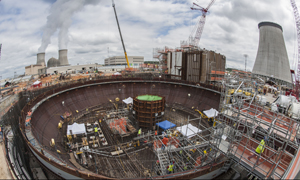Workers at a problem-plagued production facility in Louisiana that supplies components to nuclear expansion projects in Georgia and South Carolina conspired to cheat on a welder qualification test, according to the U.S. Nuclear Regulatory Commission.


As a result of the violations, the NRC announced on Sept. 26 that, after mediation, contractor CB&I has agreed to improve its quality-control and training measures at the Lake Charles, La., plant. The facility, known as Shaw Modular Solutions (SMS) prior to CB&I's 2013 acquisition of The Shaw Group, produces modular components for the Plant Vogtle project in Waynesboro, Ga., and the V.C. Summer nuclear expansion project in Jenkensville, S.C. The agency did not assess any financial penalties.
SMS self-reported the violations, which occurred in 2010, to the NRC in 2011, after discovering them as a result of reviews associated with another investigation. The NRC completed its investigation into the issue in 2013, and mediation began in May of this year.
In a Feb. 20, 2014, letter, the NRC described the scheme, which involved three plant employees. According to the agency, a welder took a qualification test on behalf of a coworker, who was aware of the cheating. The, the qualifications test administrator certified the results despite knowing they were fraudulent.
The incident showed "there was not reasonable assurance that safety-related welding processes would be controlled and accomplished by qualified personnel in accordance with applicable codes and standards," the NRC stated.
CB&I was able to document that none of the plant's work product was affected by the welders in question. The company terminated all three workers. According to the NRC announcement, CB&I has implemented a signature verification process and now is emphasizing in its training the significance of willful violations of federal regulations. The firm has revamped its weld production completion process, increased oversight of test controls and strengthened verification activities, the agency adds.
CB&I did not respond to ENR's repeated requests for comment.
Ongoing Quality-Control Issues
Operations at the Lake Charles facility have been an ongoing concern for the NRC. In 2013, after discovering a workforce fearful of retaliation for raising quality concerns—one worker was fired after noting faulty rebar, for instance—the NRC forced CB&I to enact measures to improve the plant's workplace culture.
The plant produces prefabricated wall and floor sections, called structural submodules, for the CA20 module, a component of the AP1000 reactor design being constructed at both Plant Vogtle and V.C. Summer. The submodules measure as wide as 8 ft, as high as 12 ft and as long as 69 ft and weigh up to 44 tons, according to Georgia Power officials.
William Jacobs, the Georgia Public Service Commission's independent construction monitor for the Vogtle project, has cited the plant's failure to produce a sufficient quantity and quality of materials as one factor slowing the project's progress.
In 2013, Georgia Power—and the other utilities partnering as owner— implemented a stop-work order for the Lake Charles plant. Currently, the project owner "continues to aggressively monitor the contractor's review process for release of submodules," says Georgia Power spokesman Brian Green.
"Significant progress has been made in this area," Green adds. The utility credits the progress to CB&I's decision to inspect and repair all remaining CA20 submodules at the Vogtle site.
Also, while the Lake Charles facility is continuing to fabricate some Unit 4 CA20 submodules for the Vogtle project, Georgia Power and its owner partners have contracted out structural module fabrication for certain Unit 4 modules to four other vendors, Green says.
Georgia Power is officially targeting a commercial operation date of late 2017 for Vogtle's Unit 3 and late 2018 for Unit 4. But that could be a challenge.
Jacobs told commission officials in June that builders "face many challenges" in meeting the current operation deadlines and will need to implement successfully numerous as-yet-unidentified mitigation strategies in order to maintain that schedule.





